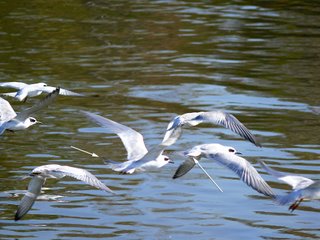Juvenal/First Winter Forster's Terns
One of the biggest challenges of my first year of birdwatching almost fifty years ago was separating young Forster's Terns from young Common Terns. And so it remains today. I find myself going back to the books every time I encounter one or the other. I had another opportunity to do just that yesterday (9 Oct 06) when I encountered 25 juvenile/first winter Forster's Terns on the beach at Caesar Creek State Park. (Directions)
I can state without equivocation that these birds were Forster's and not Common because they were quite vocal and the two species are easily distinguished by call. But looking at birds I knew to be Forster's Terns, I nevertheless experienced some confusion about several ID points. So I whipped out my trusty Panasonic Lumix DMC-FZ50 and fired off about 200 pictures. Here are the most instructive. Click on the picture or on the link for a bigger view.
 Juvenal (foreground) and first winter Forster's Terns
Juvenal (foreground) and first winter Forster's Terns
As far I was could see all 25 of the observed birds fell between the two extremes shown above. The bird in the foreground is still substantially in juvenal plumage. Truly juvenal birds would show a gingery fringe to most of the mantel feathers, scapulars and wing coverts and a dark brown cap. The fringes are all gone now and most of the back shows newly molted gray feathers. The tertials are very dark and there are still some dark-centered median coverts. The head is in the process of losing the dark feathers of forehead, crown and nape. The structure of "mask" is already evident.
The bird in the background looks very much like a basic plumaged adult, but the nape of the neck usually retains some of the darker feathers of the juvenal plumage. (The nape of the basic plumaged adult is pretty much pure white.) The flight pattern shows differences, as well, as shown in some of the pictures below.
 Advance of head molt
Advance of head molt
This collection of birds shows the range of head markings present at this date. The bird numbered "1" still shows substantially the head markings of the juvenal plumage, whereas, bird "2" shows an almost completely white forehead, crown and nape, give the masked pattern which many birders use as a diagnostic indication of Forster's Tern. The partial hood of the birds in the earlier molt stage could easily lead to confusion with basic plumaged Common Tern.
 "Carpal bars?"
"Carpal bars?"
Common Terns reliably show a carpal bar in all plumages except alternate. The photos above show that in juvenile/first winter plumage the Forster's Tern shows some dark scapulars that might be mistaken for a carpal bar. The carpal bar of the Common Tern is due to dark coverts in the patagial area and has a different look.
 Flight patterns of first winter Forster's Terns
Flight patterns of first winter Forster's Terns
First winter Forster's Terns in flight. The light-colored primaries are similar to those of the adults, but it must be noted that the wings of the first winter Common Tern lack the dark wedges that characterize the adults. This nullifies one of the best ways of separating adult Forster's and Common Terns. However, the first year Forster's lacks the dark carpal bar and the dark gray secondaries of the Common Tern
The tail is also subtly different. Note the dark markings on the inner webs of the outer two or three rectices. The detail below shows this a little more clearly. Common Tern shows a dark outer web on the outer tail feathers only. This is a significant difference, but one that is hard to spot in the field.
 Detail of tail markings of first winter Forster's Tern
Detail of tail markings of first winter Forster's Tern
